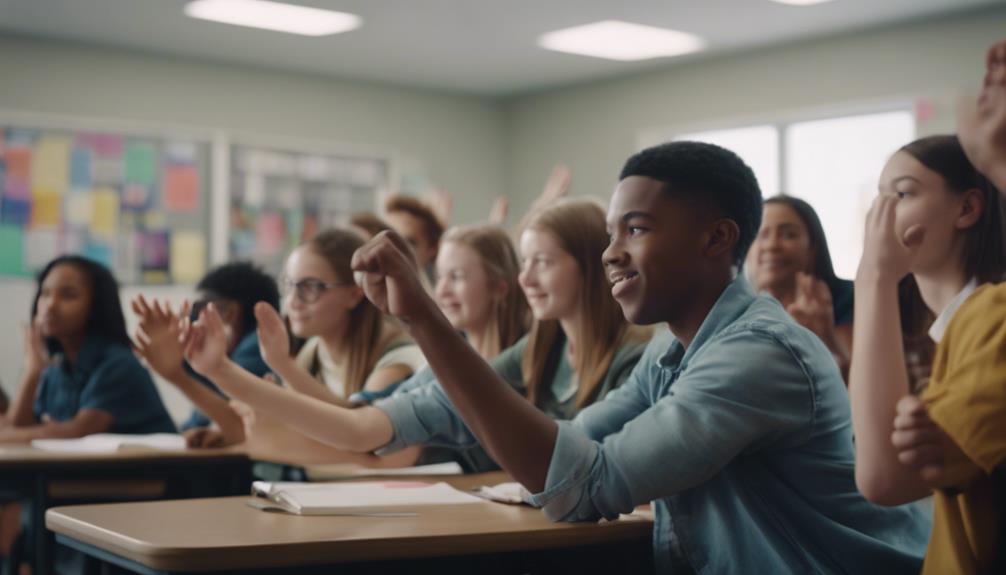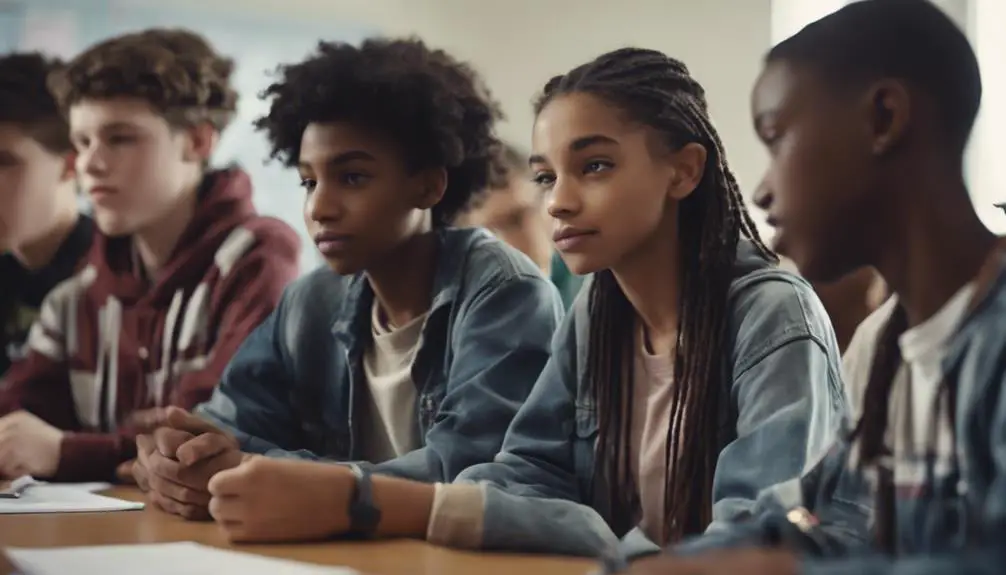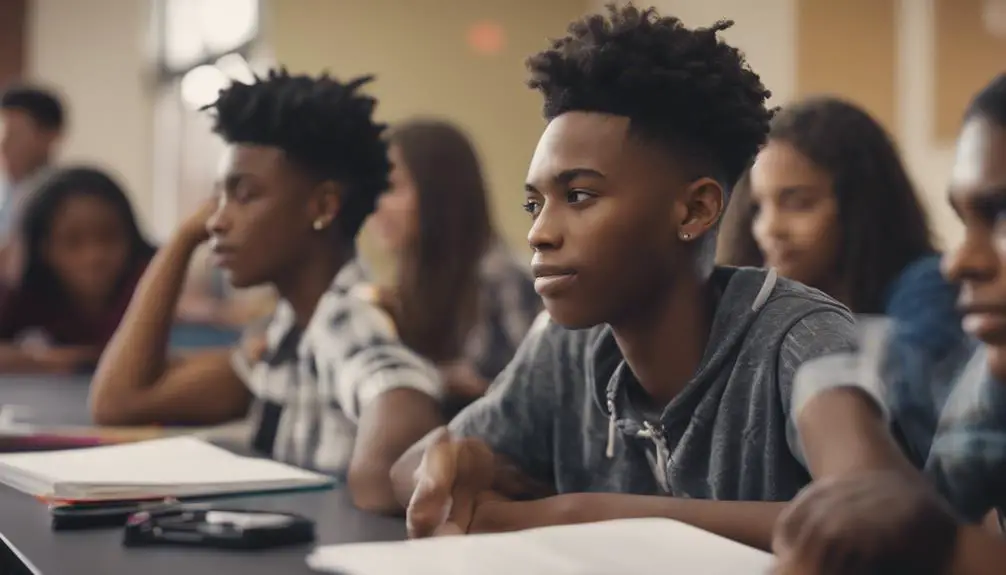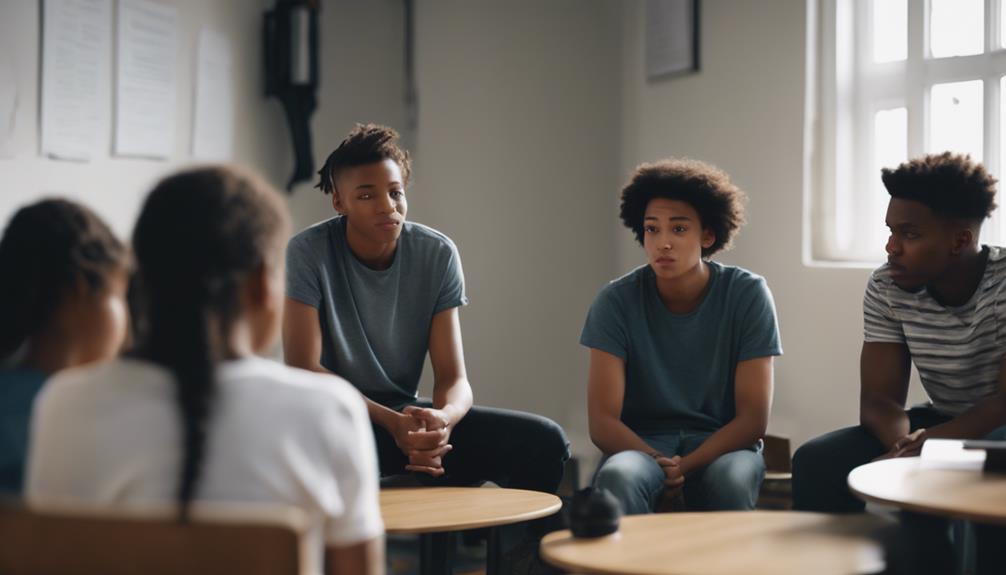Navigating the realm of education, I see questioning strategies as essential tools that lead to active engagement and profound learning for all students.
Each question I ask acts like a guiding thread weaving through the fabric of knowledge, inviting learners to explore and discover.
Whether through moments of thoughtful silence or facilitating group discussions, these strategies form the basis for dynamic class interactions and meaningful insights.
Let’s uncover the secrets of these powerful tools that can fuel curiosity and promote intellectual growth in every student.
Questioning Strategies That Actually Work in the Classroom
Below are some of the tips that I found to be helpful for effective use of questioning in my classroom:
Wait Time
Giving students time to think after asking a question is crucial for promoting thoughtful and insightful responses. This simple practice allows students to process the question, connect it to their prior knowledge, and organize their thoughts before responding. It creates a space for internal reflection, enabling students to articulate their ideas more clearly and cohesively.
Furthermore, the pause reflection technique encourages collaboration among students. They may discuss the question with a partner, fostering a sense of community in the classroom and providing different perspectives for consideration. This collaborative approach not only enhances understanding but also promotes the exchange of ideas and the development of communication and teamwork skills.
Ultimately, the act of pausing after posing a question sets the stage for a classroom environment where every student’s voice is valued. It cultivates a culture of thoughtful engagement and growth, where responses are seen as opportunities for learning and development.
No Hands Up (Except To Ask a Question)
Implementing a no-hands-up policy in the classroom boosts student engagement by requiring the teacher to call on students for answers, fostering attentiveness as they anticipate being selected next.
This strategy encourages interactive activities, peer collaboration, and engaging discussions, ultimately increasing student participation and promoting active learning. By actively involving students in discussions and responses, a dynamic learning environment is created where everyone is encouraged to contribute.
Encouraging students to be prepared to answer at any moment keeps them engaged and actively thinking about the subject matter.
This approach helps maintain a lively classroom atmosphere and ensures that all students are involved in the learning process. Through this method, the goal is to create a space where students feel empowered to share their thoughts and ideas, leading to a deeper understanding of the material through collaborative learning experiences.
By implementing this strategy, an inclusive and interactive classroom is fostered that values every student’s input and promotes a culture of respect and active engagement.
Think-Pair-Share
In class, I like to kick off discussions by asking students a question to get them thinking independently. After they’ve had a chance to ponder their thoughts, I encourage them to discuss their ideas with a partner before sharing with the whole class.
This technique, known as Think-Pair-Share, not only boosts engagement but also helps students build connections with their peers. By giving students time to reflect individually, they can solidify their thoughts and feel more confident in their responses.
When students collaborate with a partner, they get to refine their understanding together and see different perspectives. This collaborative aspect of Think-Pair-Share is particularly valuable for students who may be hesitant to speak up in front of everyone. As students share their insights with each other, the discussion becomes richer with diverse viewpoints, enriching everyone’s learning experience.
Using Think-Pair-Share in classroom conversations creates a supportive atmosphere where students feel encouraged to participate actively. It fosters a sense of community and respect among classmates, promoting collaboration. By incorporating this method, educators can empower students to engage with the material, connect with their peers, and feel more confident expressing their thoughts openly.
Bloom’s Taxonomy
I use Bloom’s to craft questions that range from simple recall to higher-order thinking like analysis and creation
Crafting questions using Bloom’s Taxonomy helps engage students by targeting different levels of thinking, from basic recall to higher-order analysis and creation. This approach guides students through a progression of cognitive skills, moving them beyond memorization to a deeper understanding and application of knowledge. When posing questions that prompt Bloom’s Analysis, students are challenged to break down information, identify patterns, and make connections between concepts, enhancing their comprehension and critical thinking skills.
Incorporating Creative Thinking in questioning techniques encourages students to approach problems innovatively and express their ideas uniquely. By crafting engaging questions that require students to think beyond the surface level, curiosity is sparked, leading to reflective responses where students contemplate their thought processes and learning strategies.
Through Bloom’s Taxonomy, the goal is to create a learning environment where students think deeply, express their ideas confidently, and engage in meaningful discussions. By integrating higher-order thinking skills like analysis and creation into questioning strategies, students are empowered to be active participants in their learning journey.
Socratic Seminar
I love using this method for deeper discussions. I pose open-ended questions and let students lead the conversation with their thoughts and questions
I facilitate engaging discussions with students using the Socratic Seminar method. By asking open-ended questions and allowing students to lead with their thoughts and queries, we can explore topics deeply. Through collaborative dialogues in Inquiry Circles, students can analyze different perspectives, leading to a more profound understanding of the subject matter. This approach empowers students to drive conversations and take ownership of their learning.
- Encouraging Critical Thinking: The Socratic Seminar method nurtures critical thinking by prompting students to ask insightful questions and consider various viewpoints, essential skills for success in academics and beyond.
- Building Communication Skills: Through participating in group discussions, students enhance their communication skills, learning to express their ideas clearly and actively listen to their peers.
- Fostering Empathy and Respect: Within Inquiry Circles, students learn to approach diverse opinions with empathy and respect, fostering a positive and inclusive learning environment.
Pose, Pause, Pounce, Bounce
Ask a question (Pose), give them time to think (Pause), choose a student to answer (Pounce), and then get them to select another student to build on their answer (Bounce)
Engaging in discussions with students involves posing a question, giving them time to think, selecting a student to respond, and encouraging them to choose another student to elaborate on the answer. This technique, known as Pose, Pause, Pounce, Bounce, promotes collaborative learning and peer feedback, creating an interactive classroom environment where students actively participate in exploring questions.
To demonstrate the Pose, Pause, Pounce, Bounce method, consider the following breakdown of the different stages of this questioning strategy:
| Stage | Description | Benefits |
|---|---|---|
| Pose | Present a question that challenges students. | Encourages critical thinking |
| Pause | Allow students time to contemplate the question. | Promotes deeper understanding |
| Pounce | Select a student to provide an answer. | Enhances student engagement |
| Bounce | Have the student choose another to expand on the answer given. | Fosters collaborative learning |
Question Stems
I provide the beginning of a question and let students complete it. It helps them focus on the key concepts and make connections
Question stems are an effective way to help students understand key concepts and make connections in discussions. By providing a starting point for their responses, students can focus on important ideas and engage in deeper thinking. This approach encourages active participation and critical thinking as students complete the questions, creating a more collaborative learning environment.
- Building Conceptual Connections: Question stems prompt students to relate new information to their existing knowledge, facilitating a deeper understanding of the subject.
- Encouraging Student Reflection: By requiring students to finish the question stems, they’re prompted to reflect on their own knowledge and experiences, leading to a more personalized learning journey.
- Promoting Peer Accountability: When students complete the question stems, they aren’t only accountable to themselves but also to their peers, fostering a sense of responsibility and participation within the group.
Question stems play a crucial role in interactive discussions, where students actively construct their responses. This method reinforces key concepts and fosters a sense of ownership over the learning process, resulting in a more enriching educational experience for everyone involved.
Randomized Calling
Using popsicle sticks or a random name generator to call on students keeps everyone prepared in case their name comes up
To boost student engagement and participation in class discussions, incorporating randomized calling through popsicle sticks or a random name generator is a dynamic strategy that ensures all students are ready for potential participation. Randomized participation not only keeps students alert but also encourages active involvement and interactive learning. By using this technique, every student is motivated to be attentive and prepared to engage, fostering a classroom environment where everyone feels included and valued.
Implementing randomized calling offers several benefits in enhancing learning:
- Engages all students and ensures everyone is prepared
- Promotes student readiness and encourages active participation
- Fosters interactive learning and creates a sense of equity
Engaging all students through randomized calling nurtures a feeling of equality among them, as each individual understands they might be called upon at any time. This approach not only motivates students to stay engaged throughout the lesson but also cultivates a culture of shared responsibility for learning. By promoting student readiness and active participation, educators can establish a more inclusive and interactive learning space where every voice is heard and respected.
Hot Seat
A student sits in the “hot seat” and the rest of the class asks them questions on a subject, encouraging peer-to-peer learning
Sitting in the ‘hot seat’, a student faces a series of questions from their classmates on a topic, promoting peer-to-peer learning. This interactive technique enhances student engagement and classroom participation by encouraging knowledge sharing among peers.
Here are three key advantages of the ‘hot seat’ method:
- Peer Learning: Students not only learn from teachers but also from each other, fostering a collaborative environment where everyone contributes to sharing knowledge and insights.
- Interactive Engagement: The dynamic nature of this activity keeps students actively participating in the learning process, stimulating critical thinking and swift recall of information.
- Student Involvement: Being in the ‘hot seat’ challenges students to think quickly, improving their communication skills and confidence while deepening their understanding of the subject through discussions with classmates.
Integrating the ‘hot seat’ strategy into classroom practices can revolutionize traditional teaching methods into lively, student-focused learning experiences. It empowers learners to take charge of their education, cultivating a culture of curiosity and mutual support within the classroom.
Exit Tickets
At the end of class, students write a response to a question. This helps me assess understanding and inform future lessons
After each class, students write responses to questions, helping me understand how well they grasped the material and guiding my future lessons. This practice of using exit tickets provides valuable insights into areas that may need further clarification or emphasis in the next session. By analyzing these responses, I can tailor my teaching to better cater to the needs of my students.
Encouraging students to give feedback to each other fosters a collaborative learning environment, prompting them to think deeply about the topics covered, ultimately enhancing their understanding. Additionally, encouraging students to think creatively and come up with innovative solutions promotes a deeper engagement with the material.
In addition to assessing comprehension, these exit tickets serve as a platform for students to engage in critical reflection, apply what they’ve learned to real-world scenarios, and synthesize their thoughts through discussions. By incorporating these elements into the exit tickets, I aim to create a comprehensive learning experience that goes beyond mere memorization to foster a deeper understanding of the subject matter.
Questioning Laddering
You start with a basic question and increase the difficulty level step-by-step, which scaffolds students’ thinking
Analyzing students’ responses from exit tickets helps me identify areas for further exploration, leading me to implement questioning laddering to scaffold their thinking effectively. Questioning progression is vital in guiding students from basic understanding to deeper insights. By gradually increasing the complexity of questions, I can support cognitive scaffolding, allowing learners to build upon their existing knowledge and develop new connections.
- Inquiry Development: Through questioning laddering, I foster a sense of curiosity and exploration in students, encouraging them to delve deeper into the subject matter.
- Thought Complexity: By challenging students with progressively more intricate questions, I push them to think critically and consider multiple perspectives, enhancing their analytical skills.
- Learning Advancement: The structured approach of questioning laddering not only promotes a deeper understanding of the material but also propels students towards continuous growth and learning.
Engaging students in this manner not only aids in their academic development but also cultivates a sense of intellectual curiosity and a willingness to embrace challenges. As educators, guiding this questioning journey can lead to profound learning experiences and empower students to become active participants in their own educational journeys.
Fishbowl
A group discusses a question while the rest of the class observes, then we switch. It gives everyone a chance to speak and listen
When we engage in a Fishbowl discussion, we create a space for active participation and a vibrant exchange of ideas in the classroom. Speaking out in the Fishbowl isn’t just about sharing our thoughts; it’s about offering perspectives, experiences, and insights that enhance everyone’s understanding. As we take turns discussing a question, those listening in have the chance to grasp diverse viewpoints, enriching their own comprehension and empathy.
The beauty of the Fishbowl method lies in its seamless role-switching. Everyone has the opportunity to be both in the spotlight and in the audience, nurturing a culture of respect and shared learning. After each rotation, we reflect together on the various ideas presented, building a tapestry of thoughts that encourage critical thinking and deeper analysis.
Through Fishbowl discussions, we ensure that every member of the class is engaged, heard, valued, and respected. This method not only promotes active participation but also cultivates a sense of community and collaboration within the learning environment.
Think Alouds
I model my thinking process as I answer a question and then ask students to do the same, showcasing problem-solving and critical thinking
When we talk about Think Alouds, it’s all about demonstrating problem-solving and critical thinking skills by sharing our thought process out loud. This strategy lets us break down our decision-making step by step, showing students how to approach challenges systematically. By verbalizing the reasoning behind our thoughts and actions, we encourage students to reflect on their own problem-solving strategies.
Think Alouds also create opportunities for interactive dialogues where students can openly share their own thinking processes. This exchange leads to dynamic discussions, where ideas and perspectives flow freely. Through this approach, students not only witness problem-solving techniques and critical thinking skills in action but also feel empowered to voice their own analytical reflections. It fosters a classroom environment where every question becomes a chance for deep exploration and collaborative learning.
Harkness Discussion
Sitting in a circle, students actively participate in a discussion during a Harkness session, highlighting their voices and fostering accountability. Circle discussions like these create a space where peer accountability flourishes, allowing students to take charge of their learning journey. The minimal intervention from teachers in this setting empowers students to express their thoughts freely, enhancing their sense of ownership over the discussion. This method not only gives students a platform to voice their opinions but also encourages them to listen actively to their peers, creating a dynamic exchange of ideas.
Student voice is at the core of Harkness discussions, emphasizing the importance of every individual’s contribution. Encouraging learners to engage in dialogue within a circle setting promotes inclusivity and ensures that everyone has an equal opportunity to share their perspectives. By actively participating in these discussions, students not only refine their communication skills but also deepen their understanding of the topic through collaborative learning.
Journaling
Using journal prompts at the beginning of a class sets a reflective tone and encourages personal engagement with the material. Reflective writing helps students explore thoughts and emotions, leading to a deeper understanding of the content.
By connecting individual experiences to the subject matter, students find meaning and relevance in their learning process. Thoughtful responses promote critical thinking and analytical skills, encouraging students to delve beneath the surface.
Quiet reflection creates a focused environment for introspection, enhancing self-awareness. Engaging prompts inspire curiosity and creativity, allowing students to express themselves authentically.
Through journaling, I aim to create a space that values personal growth, deep thinking, and individual expression, empowering students in their learning journey.
Quizzes as Launch Pads
Quizzes serve as more than just assessments; they act as catalysts for in-depth discussions on the answers and the fundamental concepts they represent. This approach sparks a higher level of engagement and comprehension among students, transforming quizzes into launching points for exploration and dialogue.
By embracing quizzes as starting points, students are encouraged to delve deeper into the material, make connections between different ideas, and foster curiosity for a better grasp of the subject matter. Analyzing both correct and incorrect answers helps students grasp the reasoning behind them, identify misconceptions, and clarify doubts, leading to improved learning outcomes. Reflecting on their own thinking processes and learning strategies enhances critical thinking skills and encourages considering various perspectives.
Moreover, this method nurtures a collaborative learning environment where students can share knowledge and build upon each other’s understanding. It promotes self-assessment and reflection on areas that need improvement while allowing students to establish personal connections to the material. Ultimately, by using quizzes as launch pads for discussions, educators can create a dynamic learning atmosphere that prioritizes exploration, analysis, and reflection.
Snowballing
When students engage in snowballing, they write down their thoughts and progressively combine and refine ideas as they join larger groups. This collaborative brainstorming method promotes idea consolidation through group synthesis, allowing for the gradual elaboration of concepts as students collectively refine their initial thoughts.
- Collaborative brainstorming: Working together in groups of increasing size enables students to benefit from a variety of perspectives and insights, enriching the depth and breadth of the discussion.
- Idea consolidation: As students merge their individual thoughts into larger group discussions, they can identify common themes, build upon each other’s ideas, and develop a more comprehensive understanding of the topic.
- Group synthesis: The snowballing process encourages students to synthesize multiple viewpoints and approaches, leading to a richer exploration of the subject matter. This collaborative effort fosters a sense of shared ownership over the ideas generated and conclusions reached.
Through snowballing, students not only participate in a dynamic exchange of thoughts but also cultivate essential teamwork and communication skills. This technique nurtures a supportive learning environment where every voice is valued, and the collective wisdom of the group guides the path towards deeper understanding.
Concept Mapping
When delving into any topic during class discussions, creating a visual map of ideas and questions proves invaluable for connecting thoughts and gaining a comprehensive understanding. Concept Mapping, also referred to as visual learning or mind mapping, enables the visualization of thoughts and the linking of knowledge. By employing techniques for mapping ideas, students can perceive the overarching concept and establish connections that mightn’t be immediately apparent through mere reading or listening. This visual depiction of concepts aids in linking thoughts, allowing learners to grasp intricate relationships and hierarchies within a subject.
Engaging in concept mapping exercises promotes active participation and deeper comprehension. As students organize their thoughts spatially, they actively process information and establish meaningful associations. This process of connecting ideas stimulates critical thinking skills and improves memory retention. Moreover, by structuring their understanding visually, learners can pinpoint gaps in their knowledge and formulate effective questions to fill those gaps.
Incorporating concept mapping into classroom conversations nurtures a collaborative environment where students can exchange their visual representations with peers, leading to more profound discussions and collective learning. Through this approach, educators can assist students in cultivating a deeper comprehension of the material by encouraging them to think beyond individual facts and instead focus on the interconnected web of ideas.
5 Whys
When I teach, I constantly ask ‘why’ to help students think critically and explore the underlying reasons behind a topic. By repeatedly questioning ‘why,’ I aim to encourage students to dig deep, moving beyond surface-level understanding to analyze the root causes of issues. This method promotes not just critical thinking but also a problem-solving approach, as students learn to seek solutions by understanding the fundamental reasons behind phenomena.
- Deep Exploration: Asking ‘why’ multiple times allows us to uncover hidden complexities and gain a profound understanding of a subject.
- Problem-Solving Mindset: Through continuous inquiry into ‘why,’ students are challenged to not only identify problems but also analyze solutions based on their exploration of root causes.
- Embracing Inquiry: Making ‘why’ a central part of our learning process creates an environment where curiosity and exploration drive knowledge acquisition, empowering students to take an active role in their education journey.
Conclusion
To sum up, using a variety of questioning techniques in the classroom is akin to planting seeds in a garden – each method fosters curiosity, critical thinking, and collaboration among students.
By incorporating strategies like wait time, Socratic Seminars, and concept mapping, teachers can create a dynamic environment where learners actively interact with the material, challenge assumptions, and build knowledge together.
Let’s continue to promote a culture of inquiry and encourage meaningful discussions in our educational settings.




















